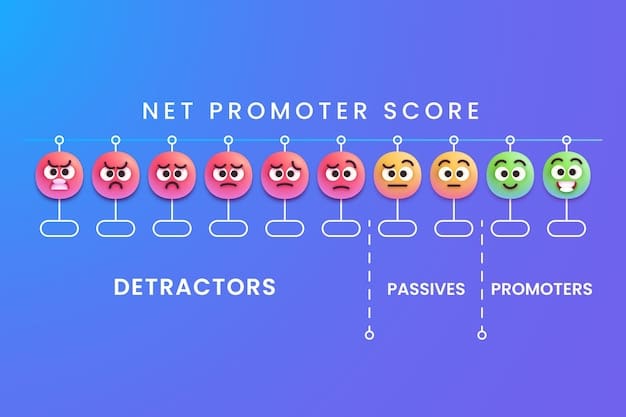Decoding Viral Tweets: 3 Key Elements of Viral Success

Decoding Viral Tweets involves identifying the key elements that catapult certain tweets into widespread popularity; examining recent viral tweets reveals patterns in humor, relatability, and emotional resonance.
Ever wondered why some tweets explode in popularity while others fade into the digital abyss? Decoding Viral Tweets involves pinpointing the secret sauce that makes content shareable and memorable. Let’s dive into recent examples and extract the essential elements behind their viral success.
Understanding the Viral Tweet Phenomenon
Viral tweets aren’t accidental; they’re often the product of cleverly crafted content that resonates with a broad audience. By examining what makes these tweets tick, we can decipher the underlying principles and apply them to our own content strategies. The goal is to understand how to amplify our message and engage communities meaningfully.
Let’s embark on a journey to scrutinize five viral tweets from the last three months. Our mission is to distill the core elements that transformed these 280-character missives into internet sensations. We will focus on what made these tweets stand out in the crowded digital landscape.

Humor as a Catalyst for Virality
Humor is a powerful tool in the arsenal of any content creator. Tweets that make people laugh are more likely to be shared, liked, and remembered. A well-timed joke or witty observation can cut through the noise and capture the attention of a vast audience. The key is to find humor that is relatable and doesn’t alienate potential followers.
The Power of Relatable Humor
Relatable humor taps into universal experiences and emotions. When people see their own struggles or quirks reflected in a tweet, they’re more likely to share it with their network. This creates a sense of camaraderie and shared experience, which can drive virality.
Using Wit and Wordplay
Wit and clever wordplay can elevate a humorous tweet from amusing to unforgettable. Puns, double entendres, and unexpected twists can make a tweet stand out and leave a lasting impression.
- Focus on everyday situations or common frustrations.
- Use concise and impactful language.
- Avoid offensive or exclusionary humor.
- Test your humor with a small group before posting.
Consider a tweet that humorously addresses the struggles of working from home, such as “My commute is now from my bed to my desk, and I’m still late.” This type of tweet resonates with a wide audience because it captures a shared experience in a funny and relatable way. The humor isn’t forced; it arises naturally from the situation, making it all the more effective. Humor, when done right, is a potent ingredient for virality.
Relatability: Connecting with Your Audience
Relatability is another cornerstone of viral content. When people see themselves reflected in a tweet, they’re more likely to engage with it. This connection fosters a sense of community and shared understanding, which encourages sharing and further engagement. So, how can you create relatable tweets?
Tweets that resonate with personal experiences, daily struggles, or common dreams often find their way into reposts and trending threads. Showcasing vulnerability and authenticity may be more effective than maintaining a facade of unattainable perfection.
Sharing Personal Anecdotes
Personal anecdotes can be a powerful way to connect with your audience. Sharing stories about your own experiences, challenges, and triumphs can make you more relatable and human.
Addressing Common Struggles
Identifying and addressing common struggles that your audience faces can also drive engagement. Whether it’s the frustration of dealing with technology or the challenges of balancing work and life, acknowledging these struggles can create a sense of solidarity.
- Be authentic and genuine in your storytelling.
- Focus on universal themes and experiences.
- Avoid overly self-promotional content.
- Engage with comments and feedback from your audience.

In one such viral tweet, a user recounts a hilariously embarrassing moment at a coffee shop, concluding with a self-deprecating punchline. The tweet gains traction not because of the extraordinary nature of the event, but because of its everyday commonality. Consider that vulnerability and relatability can be a gold mine for viral content.
Evoking Emotion: The Power of Feelings
Tweets that evoke strong emotions – whether joy, sadness, anger, or inspiration – have a higher likelihood of going viral. Emotions are powerful motivators, driving people to share content that resonates with their feelings. However, it’s essential to wield this power responsibly and ethically.
Emotion in the form of motivational content, particularly that of famous celebrities or prominent figures, is regularly circulated on the platform. Often, it is the simple, direct message of empowerment that connects with individuals, offering a source of inspiration in everyday struggles.
Inspirational Messages
Tweets that offer inspiration or encouragement can be incredibly powerful. Sharing stories of overcoming adversity, offering words of wisdom, or simply reminding people of their worth can resonate deeply.
Expressing Empathy
Expressing empathy for others can also drive engagement. Acknowledging the struggles of others, offering support, or simply showing that you care can foster a sense of community and connection.
- Be genuine and authentic in your expression of emotion.
- Avoid manipulative or exploitative tactics.
- Focus on positive and uplifting emotions when possible.
- Be mindful of the potential impact of your words.
For example, a tweet expressing gratitude for healthcare workers during a crisis evokes positive emotions and resonates with a broad audience. Similarly, tweets that highlight acts of kindness or generosity can inspire others to do the same. The emotional connection encourages people to share the content and spread the positive message. The ability to stir an emotional response is a crucial factor in virality.
Analyzing Viral Tweet Examples
To further clarify these elements, let’s look at five concrete examples of tweets that have gone viral in the last three months. We’ll dissect each tweet, identifying the specific elements that contributed to its success. This hands-on approach will provide valuable insights into the art of crafting viral content, by highlighting both the do’s and don’ts of the viral algorithm.
By studying top tweets, you can learn how to apply these theories to your own content and improve your marketing content. Always keep in mind that algorithms change, and that you should tailor to new trends to stay relevant within your niche.
Example 1: Humorous Observation
This tweet featured a humorous observation about the absurdity of modern technology. Its success stemmed from its relatability. Many users find a humorous reflection of themselves, and find the desire to share it with those they know.
Example 2: Personal Anecdote
This tweet shared a personal anecdote about a funny encounter. While sharing experiences can be a good way to gain traction, be cautious about oversharing. Consider the potential implications and whether your content aligns with your target demographics.
- Identify the core message of each tweet.
- Analyze the language and tone used.
- Consider the timing and context of the tweet.
- Assess the audience’s reaction and engagement.
Consider a tweet that humorously plays on the generational divide regarding technology, such as, “Millennials explaining TikTok to Baby Boomers is like trying to teach a cat to do algebra.” This tweet resonates because it captures a familiar, often frustrating, interaction in a lighthearted way. Similarly, a tweet sharing a heartwarming story about a random act of kindness can evoke positive emotions and inspire others. Each tweet’s success is deeply rooted in its ability to connect with people on a personal level, demonstrating that understanding your audience and their emotional triggers is key when targeting the algorithm in your niche.
Ethical Considerations in Viral Content
While the pursuit of virality can be exciting, it’s crucial to consider the ethical implications of your content. Spreading misinformation, engaging in manipulative tactics, or exploiting vulnerable audiences can have serious consequences. Ethical content is transparent, respectful, and responsible. But how to measure responsibility when it comes to virality?
Transparency means being upfront about your intentions and avoiding any hidden agendas. In viral content, it means not being misleading. You should also have respect for your audience, avoiding content that is overly sensationalized, biased political opinions, or content that could ostracize groups of people.
Avoiding Misinformation
Ensure that all information you share is accurate and verified. Misinformation can spread rapidly online, leading to confusion, anxiety, and even harm. Cross-reference the information with trusted sources.
Respecting Privacy
Be mindful of privacy concerns when sharing personal stories or anecdotes. Obtain permission from individuals before sharing their information or experiences. If they are not willing, refrain from sharing.
- Fact-check all information before sharing.
- Obtain consent before sharing personal information.
- Avoid spreading harmful stereotypes or misinformation.
- Be transparent about your intentions and motivations.
Consider a tweet that promotes a positive environmental message by sharing verified facts about climate change and actionable steps people can take to help. This type of content is not only ethical but also educational and empowering. Conversely, spreading false claims about a product or service or engaging in deceptive marketing practices is unethical and can damage your reputation. Always prioritize integrity and responsibility in your pursuit of virality.
Leveraging Trends and Hashtags
Trends and hashtags can be powerful tools for amplifying your message and reaching a wider audience. By tapping into existing conversations and movements, you can increase the visibility of your tweets. The hashtag should be short, specific, and relevant. You can also use related hashtags to get further reach.
Hashtags categorize your content into different keywords. As such, hashtags can be powerful tools for marketing your content and getting visibility. Trending hashtags are especially useful, as this will place your content into a high-volume space of content.
Identifying Relevant Trends
Keep an eye on trending topics and hashtags that align with your content and values. Tools like Twitter Trends and Google Trends can help you identify relevant opportunities.
Using Hashtags Strategically
Incorporate relevant hashtags into your tweets to increase their visibility. Use a mix of broad and specific hashtags to reach a diverse audience.
- Research trending topics and hashtags regularly.
- Use a mix of broad and specific hashtags.
- Avoid overusing hashtags or hashtag stuffing.
- Engage with conversations and communities around relevant hashtags.
For example, tweeting about a new tech gadget using relevant hashtags like #TechNews, #GadgetReview, and #Innovation can increase visibility among tech enthusiasts. Similarly, participating in a trending conversation about mental health with hashtags like #MentalHealthAwareness and #SelfCare can foster connection and community. Be sure to keep your hashtags relevant and diverse for better engagement.
| Key Element | Brief Description |
|---|---|
| 😂 Humor | Using jokes or wit to connect with users. |
| 🤝 Relatability | Sharing experiences everyone can understand. |
| 💖 Emotion | Evoking feelings to inspire or comfort others. |
| #️⃣ Hashtags | Using hashtags in every keyword to market. |
[Frequently Asked Questions]
What makes a tweet go viral?
▼
A tweet goes viral when it resonates with a large audience, prompting widespread sharing due to humor, relatability, or emotional impact, often amplified by trending hashtags.
▼
Humor acts as a catalyst by capturing attention, making content memorable, and encouraging sharing among users who find the tweet amusing and relatable.
▼
Relatability fosters connection as people see their own experiences reflected in the tweet, creating a sense of community and shared understanding that encourages engagement and sharing.
▼
Emotions drive people to share content that resonates with their feelings, whether it’s joy, sadness, anger, or inspiration, motivating them to spread the message and connect with others.
▼
Ethical considerations include avoiding misinformation, respecting privacy, being transparent, and ensuring content is responsible and truthful, prioritizing respect for the audience.
Conclusion
Understanding the elements that drive virality on Twitter is crucial for anyone looking to amplify their message and connect with a broader audience. By focusing on humor, relatability, and emotional resonance while adhering to ethical guidelines, you can create tweets that capture attention and spark engagement. Embracing these insights and adapting them to your unique voice and style will help you navigate the dynamic landscape of Twitter and achieve viral success.





